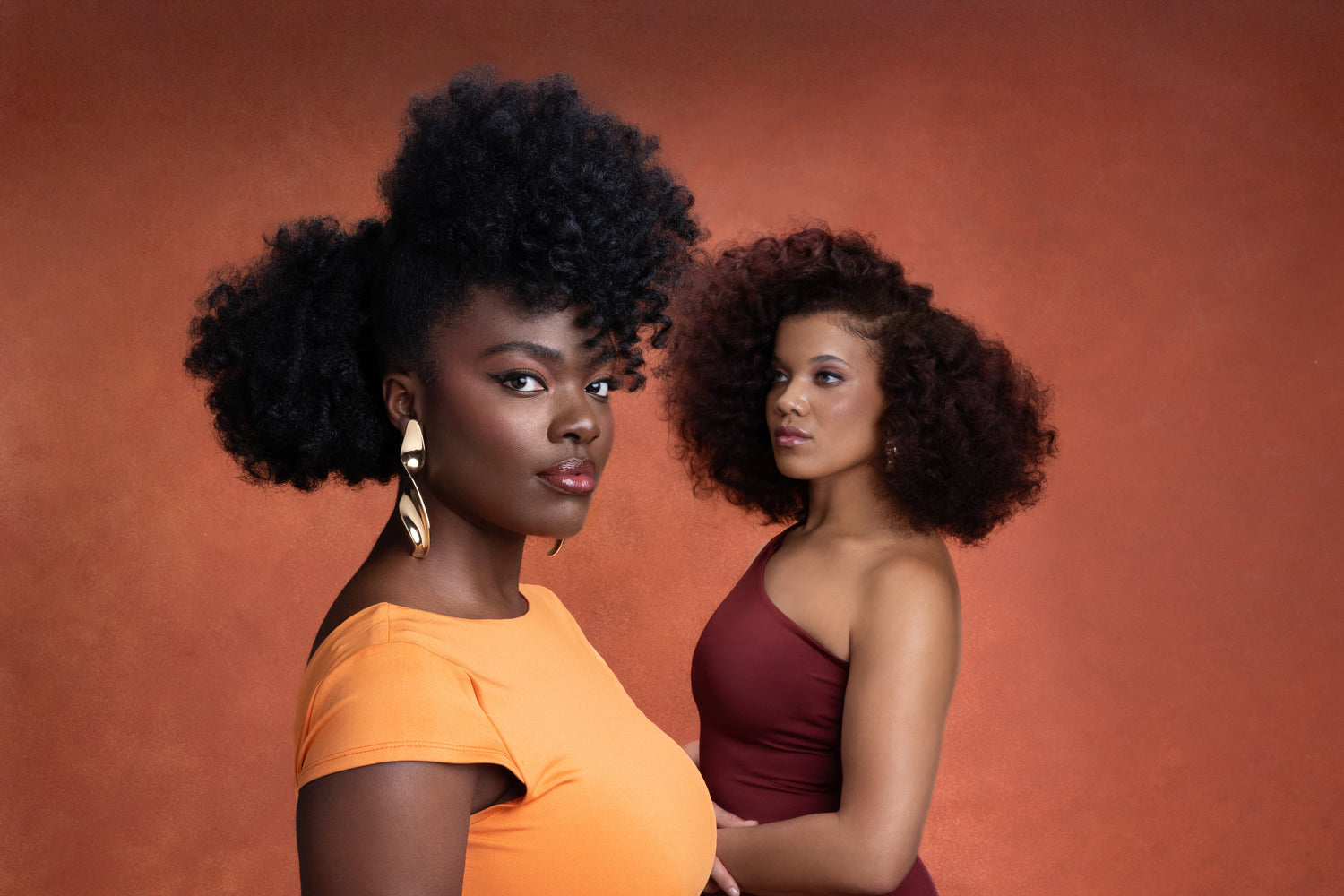The main causes of hair breakage are typically dry hair and frequent manipulation, but there are many different causes. Structurally, our hair cuticle is made of overlapping 'scales' which help keep your hair strand together. In healthy, undamaged hair, these scales are intact, however breakage can occur when these scales are damaged or fall apart.
A common complaint we hear is about hair not growing. In most cases, it is growing, it's just breaking as fast as it grows. This has also played a part in adding to the myth that afro hair doesn't grow. However, breakage is the culprit of the myth that afro hair doesn't grow. Afro hair grows just like other hair types but if the rate of breakage is faster than the rate of growth, then you'll struggle to retain length.
Want to stop your afro hair breaking? Carry on reading to discover some common causes and treatments.
1. Dryness
Dry hair is prone to breakage and damage, and can be caused by multiple factors.
When it comes to Afro and curly hair, the twists and turns make it harder for sebum (the natural oils your scalp produces) to travel down the hair strand. This means afro and curly hair is dryer than other types.
You can combat dryness by using the LOC and LCO methods, which involve the layering of products. Both are acronyms where:
L = liquid O = oil and C = cream
The order of the letters guides the order in which the products should be applied to the hair.

Our Moisture Surge Set contains products for all three steps — Sheen natural moisturising spray (liquid), Seal (hair oil) and Smooth (moisturising cream) and stops afro hair breaking.
Also, many of us are guilty of this afro hair error. Covering your hair at night can really save your hair.
Cotton absorbs moisture, which is great when it comes to clothing but it's detrimental to the health of your hair. Sleeping with a satin bonnet helps to maintain your hair’s moisture as well as preserving your hair from forming tangles which lead to breakage. If you dislike hair scarves and bonnets, we suggest opting for a silk pillowcase.
2. Heat Damage
In one of our previous posts on avoiding heat damage, we mentioned high temperatures cause the hair cuticle to be raised, not only leaving the delicate cortex of the hair vulnerable to damage but also allowing moisture to escape. Heat styling is one of the main culprits for breakage, especially if you have tight curls. Blowdryers and straighteners strip moisture from the hair, so try to avoid and use heat-free methods to dry or style your hair.
3. Improper Towel Drying
As we mentioned, using heat can lead to breakage but did you know improperly drying your hair can lead to hair breakage? Regular cotton towels cause friction which raises the cuticles of your hair strands. Friction causes frizz. Microfibre towels are designed to create less friction (which means less frizz!) and prevent breakage so it’s a win-win for your Afro.
Using a towel turban makes it easy to put your hair up to dry and go hands-free. So you can easily do something else while saving time and drying your hair. Just watch our video to see how to use our towel turban with ease.4. Washing Your Hair (The Wrong Way)
Shampoos are great for removing dirt but some also strip the hair of its natural moisture. As a general rule of thumb, we advise using a gentle sulphate free shampoo, which can help provide a crisp clean and remove buildup without stripping your hair of moisture.
Watch our video, below, to learn how to wash your hair the right way.
5. Terrible Tools
Step away from the hard bristle brushes and fine-toothed combs. These are enemies of healthy hair. Opt for finger-detangling instead as you’re more likely to be gentle with your hands than with a comb because you can easily feel for knots and tangles.
To finger detangle, simply coat your fingers with oil (we suggest Soothe or Nourish as they’re super lightweight!) and work through sections of your hair, starting at the ends and working your way up to the roots. Once a section is detangled, you can twist or braid it to keep it from tangling.
Editor’s tip: You can also limit hair damage by gently using an Afrocenchix detangling brush or wide tooth comb.
6. Poor Accessories
Excited by the prospect of styling your hair, but unsure if the accessories you are using are the best for you hair? Using poor accessories that easily snag your hair could be the cause of your hair breakage. So make sure to throw away those broken bobby pins and clips.
Looking for new safe accessories? Try our Essential Accessories Pack, so you can rest at ease. They are friendly for afro/curly hair – and in fact for all hair types!

7. Over-processing
Over-processing or chemically treating your hair can also lead to an increase in hair breakage. Perms, relaxers, other types of permanent straightening, as well as hair colouring/dyeing can leave your hair susceptible to hair damage and breakage.
Looking to stop chemically treat your hair? Don't forget to check our article on transitioning for practical tips.
8. Wearing Your Hair Out
When you wear your hair down it gets exposed to elements in the air, material on your clothing and other things that can cause friction that leads to breakage. Wearing your hair up in a bun or any style off your shoulders stops the friction which causes breakage.
Protective styles are a great way of literally protecting your hair from the elements as they keep the ends of the hair tucked away. Why is this important? Well, the ends of the hair are the oldest and weakest parts of the hair so they need to be handled with care.
9. Tight Protective Styles
We've just mentioned protective styling is great but these styles can be counterproductive to healthy hair growth if installed badly and if you neglect your hair while your style is in.
Although Afro hair thrives when tucked away, your hair still requires moisture while you're rocking your braids. Moisture is essential for keeping your hair healthy and minimising breakage.
Don't forget: You will still need to wash and condition your hair for good braid care. Not sure how to do this? Read our article on how to wash your box braids.
Between washes, spray a light mist of a moisturising spray every morning and night directly on your hair. You'll really see the difference this makes after removing your braids! Instead of feeling hard and crunchy, your hair will be soft and luscious! You can also get everything you need to look after your hair with our Braid Care Set.
Pro tip: We strongly recommend that you speak up at the hair salon if they are pulling too tightly, using too much heat or a fine tooth comb.
And remember you should never sacrifice your hair health for a hairstyle! If you're stuck try out a low manipulation style that doesn't require braiding or twisting such as a bun or roll and tuck style. You can check out our style page for inspiration!
10. Diet
A healthy and balanced diet is essential to hair and your health. If you're suffering from hair breakage, having a look at your diet might be useful, especially if you've made recent or significant changes. So make sure you are getting all the nutrients you need to grow and flourish.
Easy things you can do is make sure you’re having five portions of fruit and veg each day and try to avoid sweets and fatty foods.
11. Stress
Of all the things that cause breakage, stress might be the trickiest to deal with - not because there aren’t solutions (there are), it’s just that everyone deals with stress differently.
Telogen effluvium is a temporary form of hair loss that usually happens after stress, a shock or a traumatic event. It can make your hair follicles go dormant, which means that hair that's in the middle of a growth cycle may easily break off.
Effective stress management would be recommended for hair breakage related to stress. So do something nice to help you relax and remember: self care isn't selfish.
More Articles:

